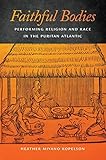Faithful Bodies : Performing Religion and Race in the Puritan Atlantic / Heather Miyano Kopelson.
Material type: TextSeries: Early American Places ; 13Publisher: New York, NY : New York University Press, [2014]Copyright date: ©2014Description: 1 online resourceContent type:
TextSeries: Early American Places ; 13Publisher: New York, NY : New York University Press, [2014]Copyright date: ©2014Description: 1 online resourceContent type: - 9781479805006
- 9781479814268
- 305.800974 23
- F75.A1 K67 2016
- online - DeGruyter
| Item type | Current library | Call number | URL | Status | Notes | Barcode | |
|---|---|---|---|---|---|---|---|
 eBook
eBook
|
Biblioteca "Angelicum" Pont. Univ. S.Tommaso d'Aquino Nuvola online | online - DeGruyter (Browse shelf(Opens below)) | Online access | Not for loan (Accesso limitato) | Accesso per gli utenti autorizzati / Access for authorized users | (dgr)9781479814268 |
restricted access online access with authorization star
http://purl.org/coar/access_right/c_16ec
Inthe seventeenth-century English Atlantic, religious beliefs and practicesplayed a central role in creating racial identity. English Protestantismprovided a vocabulary and structure to describe and maintain boundaries betweeninsider and outsider. In this path-breaking study, Heather MiyanoKopelson peels back the layers ofconflicting definitions of bodies and competing practices of faith in thepuritan Atlantic, demonstrating how the categories of "white,""black," and "Indian" developed alongside religious boundaries between"Christian" and "heathen" and between "Catholic" and "Protestant."Faithful Bodies focuses on threecommunities of Protestant dissent in the Atlantic World: Bermuda,Massachusetts, and Rhode Island. In this "puritan Atlantic," religiondetermined insider and outsider status: at times Africans and Natives couldbelong as long as they embraced the Protestant faith, while Irish Catholics andEnglish Quakers remained suspect. Colonists'interactions with indigenous peoples of the Americas and with West CentralAfricans shaped their understandings of human difference and its acceptableboundaries. Prayer, religious instruction, sexual behavior, andother public and private acts became markers of whether or not blacks andIndians were sinning Christians or godless heathens. As slavery becamelaw, transgressing people of color counted less and less as sinners in Englishpuritans' eyes, even as some of them made Christianity an integral part oftheir communities. As Kopelson shows, this transformation proceededunevenly but inexorably during the long seventeenth century.
Mode of access: Internet via World Wide Web.
In English.
Description based on online resource; title from PDF title page (publisher's Web site, viewed 01. Nov 2023)


